Key takeaways:
- Filmmaking style combines technical aspects and personal expression, evolving with each project influenced by life experiences.
- Embracing vulnerability and personal influences enriches storytelling, creating deeper connections with the audience.
- Experimentation with genres and techniques, such as unconventional angles and visual storytelling, enhances a filmmaker’s style.
- Seeking diverse feedback is crucial for growth, as it can reveal blind spots and improve storytelling effectiveness.
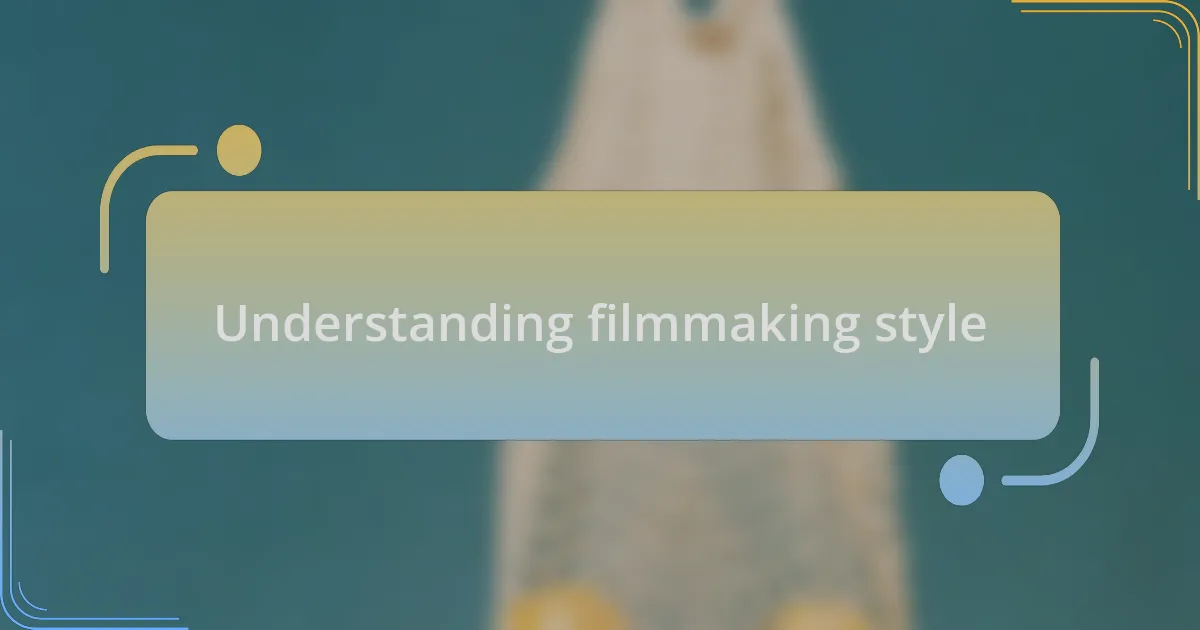
Understanding filmmaking style
Understanding filmmaking style isn’t just about the technical aspects; it’s also deeply connected to personal expression. For me, discovering my style involved reflecting on the films that resonated with me emotionally as a viewer. Have you ever watched a movie and felt like it spoke directly to your soul? That feeling is what I sought to capture in my work.
One pivotal moment in my journey was during a short film project where I experimented with lighting. I chose to illuminate my scenes in a way that mirrored my character’s internal struggles. It was mesmerizing to see how a simple shift in light transformed the mood and brought depth to the story, making me realize that style is heavily influenced by how we choose to frame our narratives.
I also find that my filmmaking style evolves with every project. It’s a dynamic process, driven by experiences, themes, and the emotions I wish to convey. Have you considered how your own life experiences shape your creative choices? The more I embrace vulnerability in my storytelling, the more authentic my style becomes, encouraging a genuine connection with my audience.
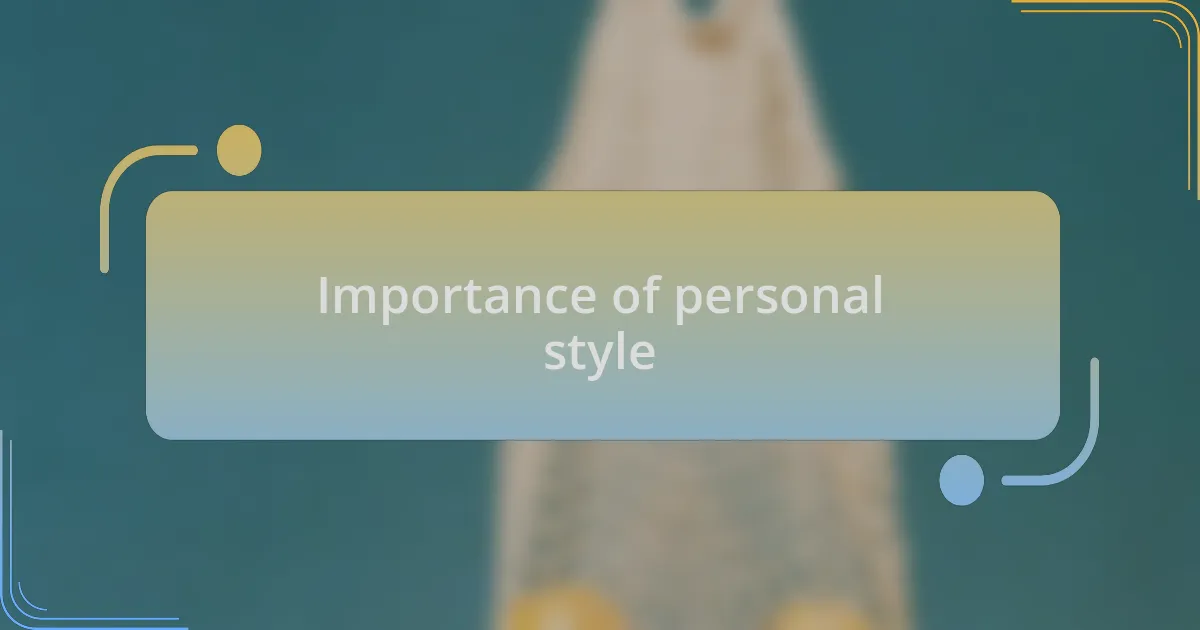
Importance of personal style
Personal style in filmmaking is a crucial element that defines how a director communicates with the audience. I remember the moment I decided to incorporate more abstract visuals in my work, inspired by a film that left me pondering its meaning long after the credits rolled. This choice not only set my films apart but also encouraged viewers to engage with my work on a deeper level. Can you recall a film that lingered in your mind because of its unique visual language? That’s the power of personal style.
I’ve found that embracing my influences—whether it’s a passion for classic noir or a fascination with modern surrealism—has helped shape my narrative approach. For instance, during one of my projects, I borrowed elements from “film noir,” using shadow and light to enhance tension. This technique allowed me to weave a story that was not only visually captivating but also emotionally charged. Isn’t it interesting how the echoes of past inspirations can enrich our storytelling today?
What truly amplifies personal style is the willingness to be vulnerable. I once shared a raw, autobiographical story that revealed my fears and dreams, and the response was overwhelming. Audiences connected with the honesty and felt seen in a way that was powerful. How often do we share pieces of ourselves in our work? I believe that when we do, we create something that resonates deeply—a film that evokes emotions, invites reflection, and encourages discussions long after it has ended.
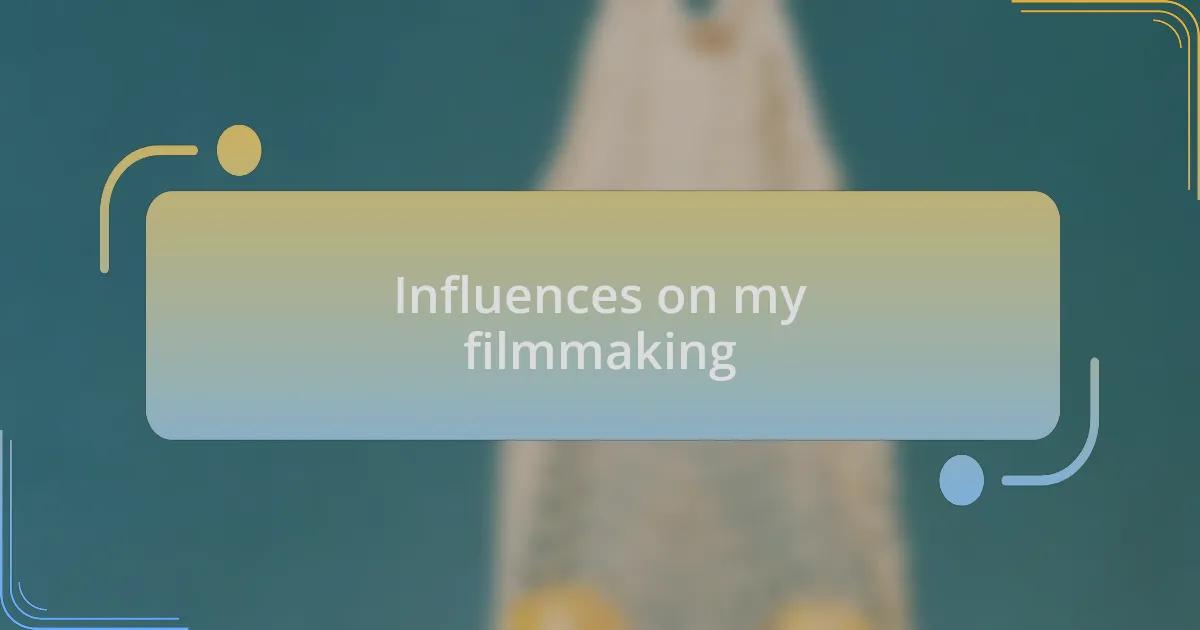
Influences on my filmmaking
When I think about the influences on my filmmaking, I can’t help but recall the directors who have left a significant mark on my vision. A viewing experience that changed everything for me was watching a Terrence Malick film; his poetic use of nature as a storytelling device inspired me to experiment with capturing emotion through my surroundings. Have you ever felt the landscape in a film spoke to you as much as the characters did? That unique blend of visuals and emotion is something I strive to replicate in my own work.
Music has also been a profound influence on my filmmaking journey. During the editing of one of my short films, I stumbled upon an old jazz record that perfectly encapsulated the mood I was aiming for. I found myself syncing the edits with the rhythms, which added a whole new dimension to my storytelling. It’s fascinating to think about how sound can elevate visuals—isn’t it astounding how a single piece of music can transform a scene?
Moreover, I draw inspiration from my travels. I once filmed a scene in a bustling market in Morocco, and the vibrant colors and dynamic interactions ignited a creative spark in me. It taught me the importance of immersing myself in different cultures. This experience makes me reflect: how often do we step outside our comfort zones to enrich our art? I firmly believe that every new experience we embrace adds a layer to our unique filmic language.
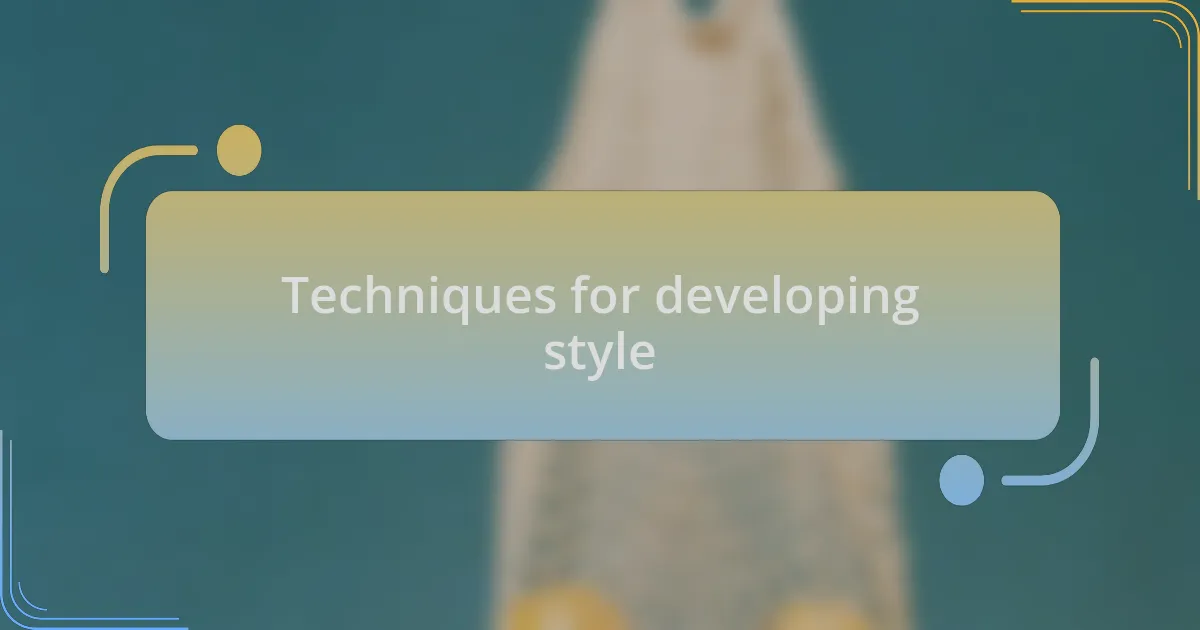
Techniques for developing style
Techniques for developing style
Exploring various techniques is essential in shaping one’s filmmaking style. One method I often employ is the use of unconventional angles and framing. During a project where I filmed a quiet moment between two characters, I placed the camera at an unusual low angle. This choice not only created a sense of intimacy but also allowed me to convey the weight of the moment in a fresh way. Have you considered how a simple shift in perspective can significantly alter a scene’s emotional resonance?
Another powerful technique I’ve found is the integration of visual storytelling with minimal dialogue. One time, I filmed a short piece that focused primarily on gestures and facial expressions to communicate the characters’ feelings. Reducing the reliance on words challenged me to truly harness the power of visual language. It raised the question for me: how much can we say without saying anything at all?
Experimentation with color palettes has also played a significant role in defining my style. In a recent film, I carefully chose muted tones to evoke a sense of nostalgia, imbuing the narrative with a poignant depth. This experience taught me that colors can have emotions—each hue carries a weight that can either enhance or detract from the story. Have you ever thought about how the colors in a film shape your emotional experience?
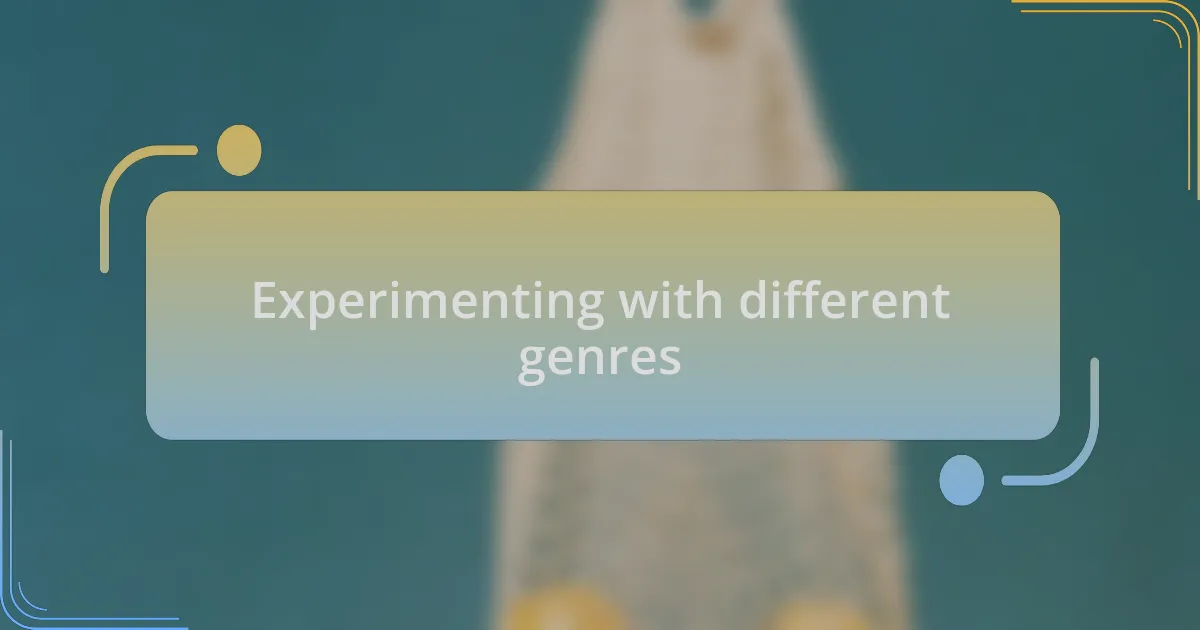
Experimenting with different genres
Diving into different genres has been a transformative experience for me as a filmmaker. For instance, I once transitioned from a dramatic narrative to creating a light-hearted comedy. This shift forced me to adjust my storytelling instincts and explore humor in new ways. I remember the thrill of discovering that the same character arc could evoke laughter instead of tears. Isn’t it fascinating how genre can alter an audience’s emotional journey?
I’ve also experimented with blending genres, which has been incredibly rewarding. In one project, I fused elements of horror and romance, crafting a story where love flourished under the looming shadow of fear. It was during the editing process that I realized the unique tension this combination created, leading the audience to experience love in a more profound way. How often do we see love emerge in the most unexpected circumstances?
Sometimes, I embark on a genre I’m entirely unfamiliar with, which opens up a wealth of creative possibilities. I once attempted to make a documentary about street art, a departure from my usual fiction work. Immersing myself in this vibrant world allowed me to appreciate the spontaneous nature of storytelling from real-life events. This experience reinforced for me the idea that stepping outside our comfort zones can lead to unexpected growth and spark fresh inspiration. Have you tried venturing into uncharted territory in your own creative endeavors?
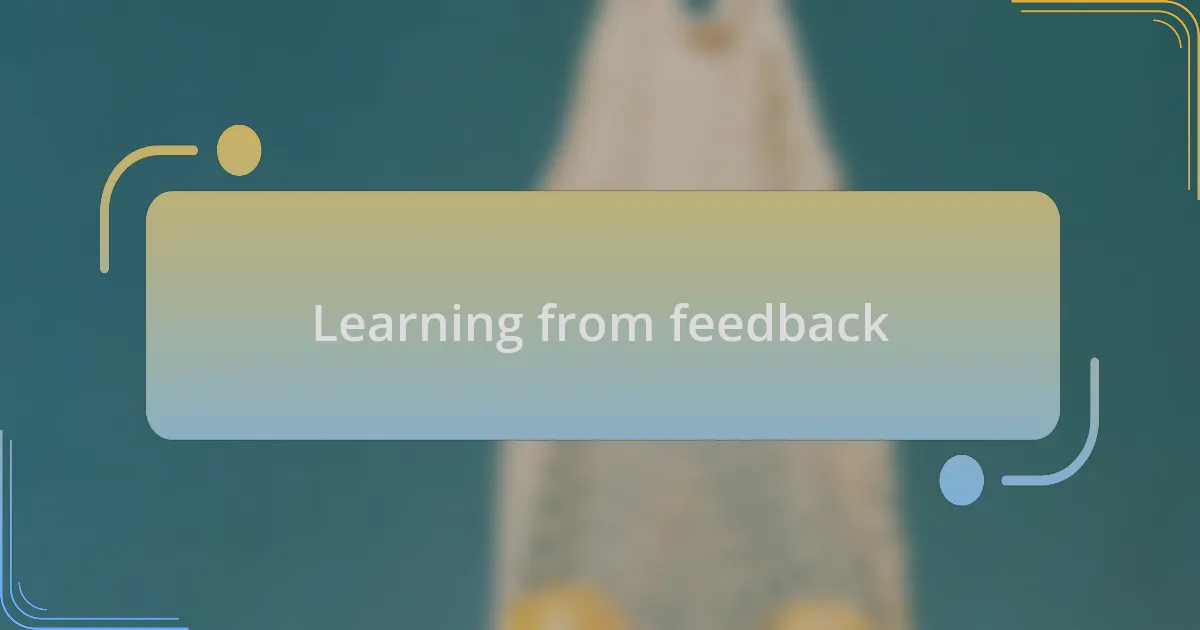
Learning from feedback
Learning from feedback is an essential part of my filmmaking journey. I vividly remember screening one of my early short films to a small group of friends. Their candid reactions were eye-opening; some moments I thought were poignant landed flat, while scenes I barely considered resonated deeply. This stark contrast taught me the importance of perspective and the value of listening to others’ interpretations.
In another instance, I submitted a project to a film festival and received feedback that challenged my initial vision. The judges pointed out a pacing issue I had overlooked. Initially, it stung, but I took their advice to heart and revised the cut. The resulting film was a tighter, more engaging narrative, proving that constructive criticism can profoundly enhance a project. Reflecting on this, I often wonder: how many opportunities for growth do we miss by dismissing feedback too quickly?
Subsequently, I’ve made it a habit to seek out feedback from a diverse range of viewers—filmmakers, critics, and even casual audiences. Their varied perspectives often illuminate blind spots I never considered. This ongoing dialogue not only sharpens my skills but also deepens my understanding of what resonates with different audiences. Isn’t it invigorating to realize that every piece of feedback can be a stepping stone toward better storytelling?
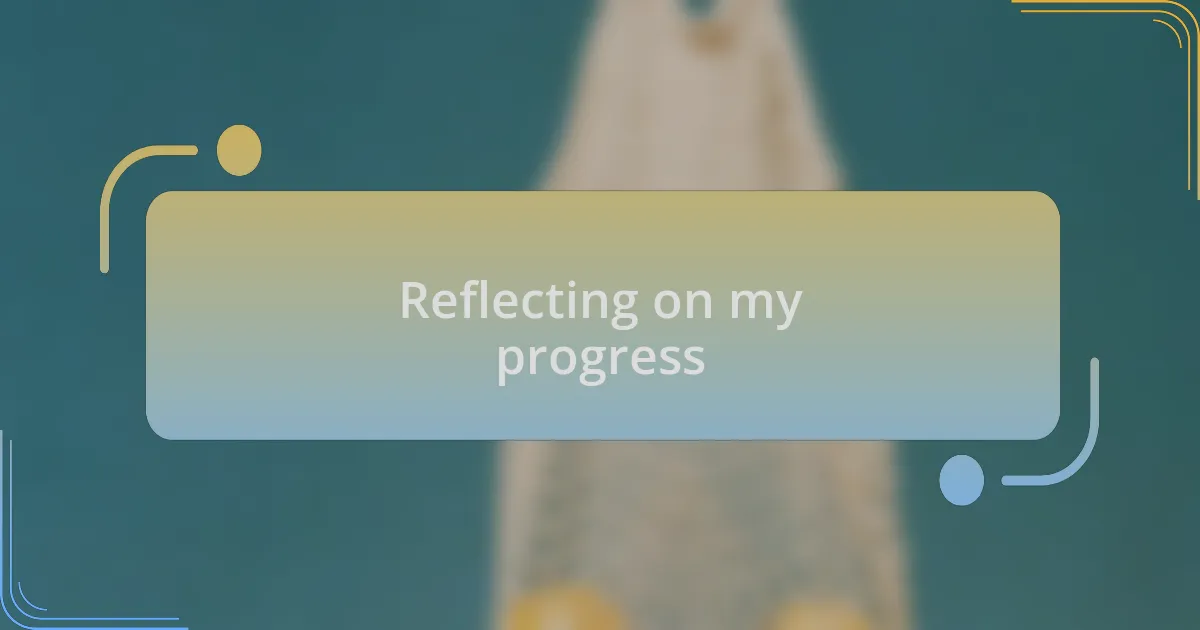
Reflecting on my progress
Reflecting on my progress has become a crucial practice in my filmmaking journey. I often find myself revisiting my early projects, feeling a mix of nostalgia and embarrassment at the missteps I took. However, I also recognize how those moments shaped my artistic voice. Can you imagine how valuable it is to witness how much we’ve evolved over time?
There was a particular project where I attempted a complex visual effect that didn’t quite land as intended. Looking back, I remember the frustration I felt during the editing process, wrestling with what I thought would be a creative breakthrough. Now, I see that experience as a catalyst for my growth. I learned that sometimes simplicity speaks louder than an overcomplicated idea—also, it’s a good reminder that not every bold choice translates to success.
As I continue to nurture my filmmaking style, I take time to reflect on each completed film. I ask myself: what worked, and more importantly, what didn’t? This introspective process not only helps me refine my skills but also reconnects me with the emotional core of my projects. With every reflection, I feel a renewed commitment to crafting stories that resonate deeply—both for me and my audience. Isn’t it fascinating how self-reflection can illuminate the path forward?